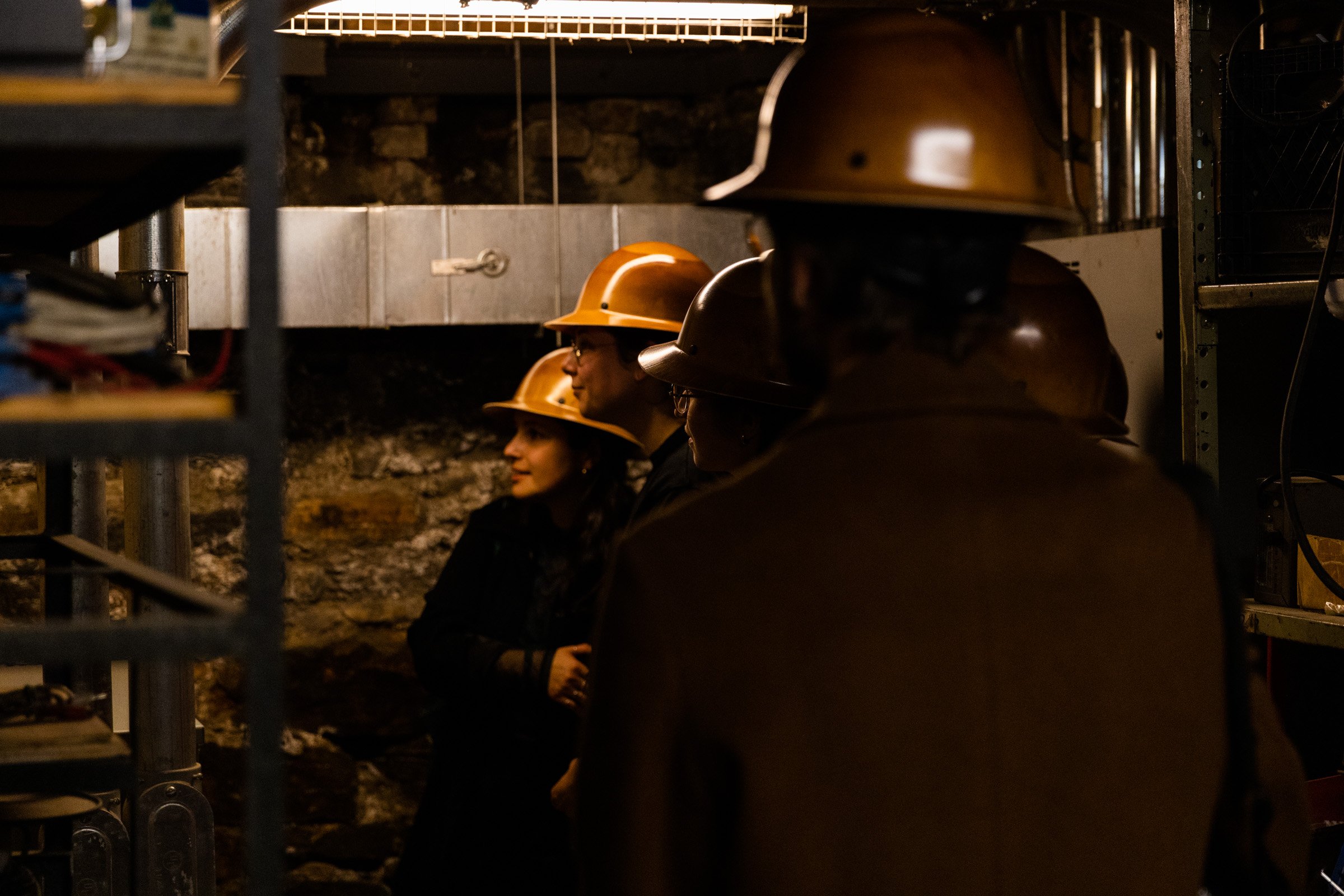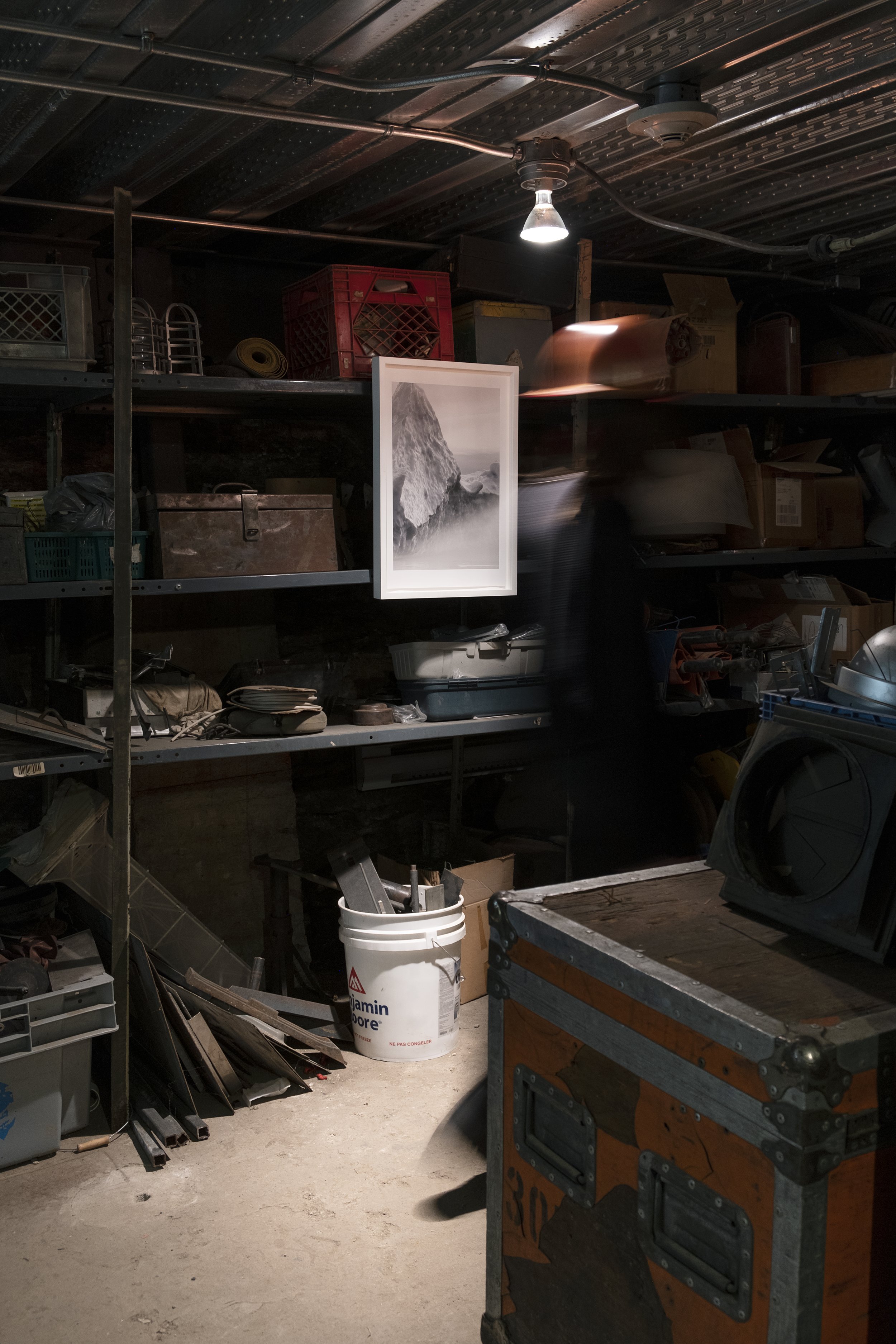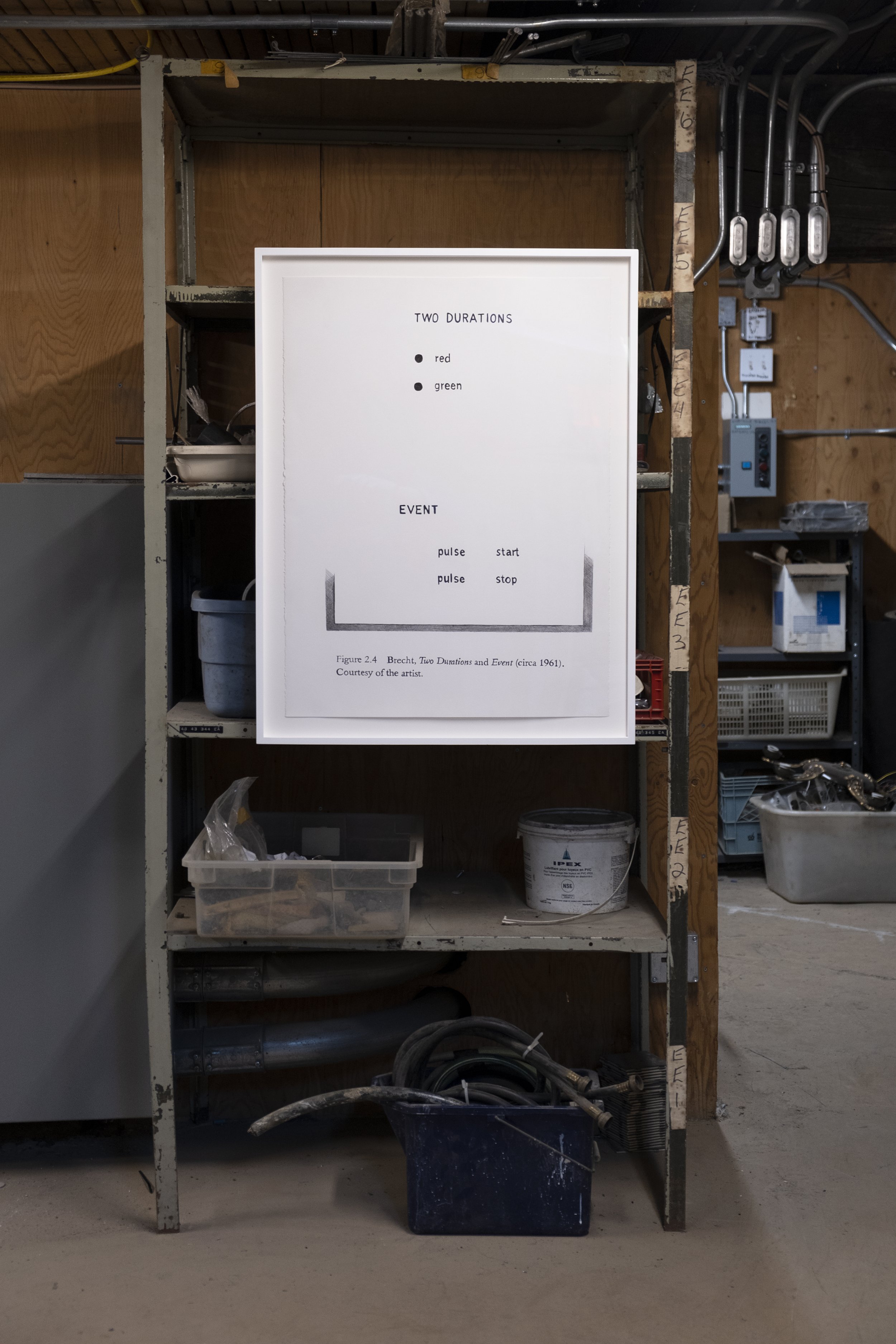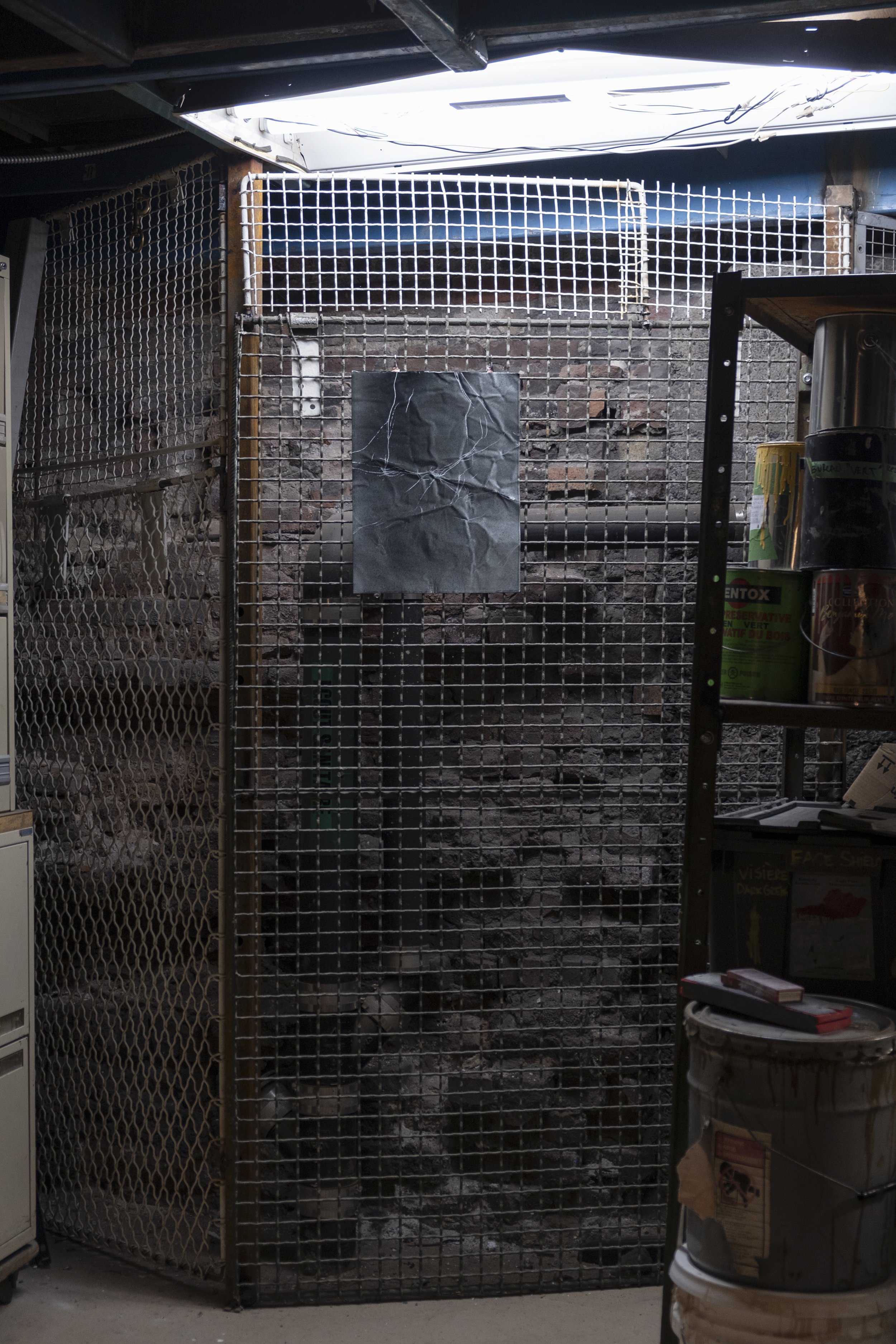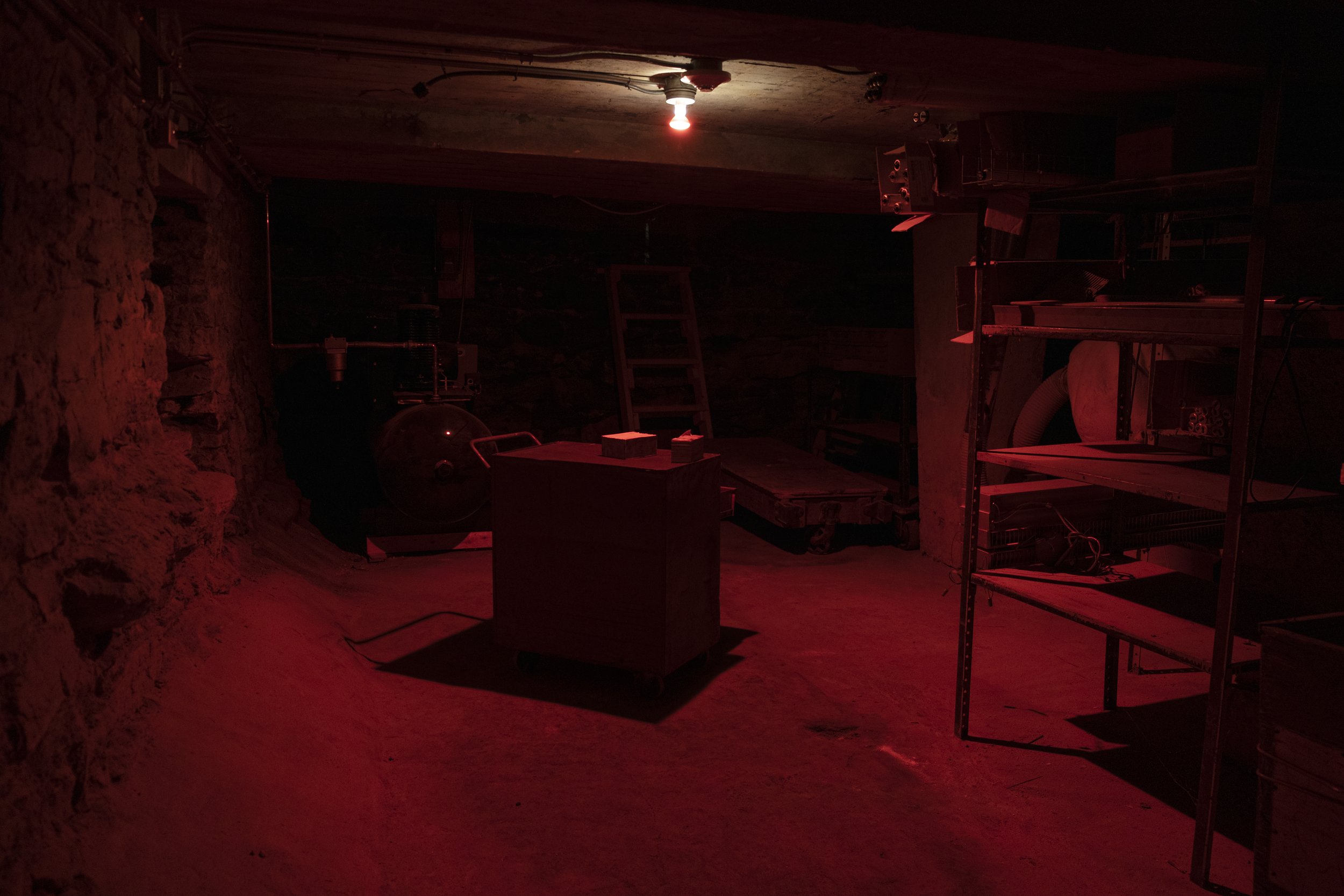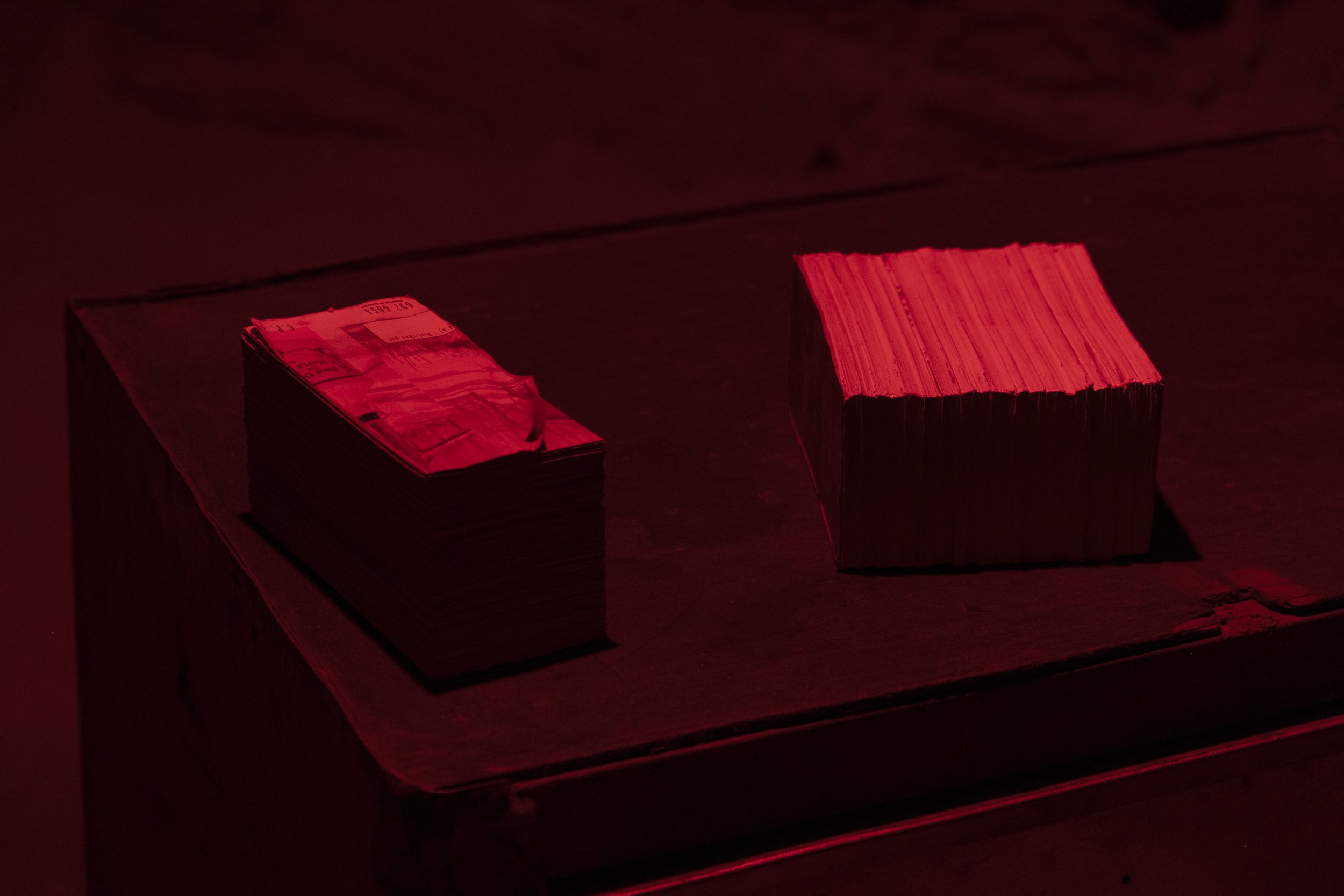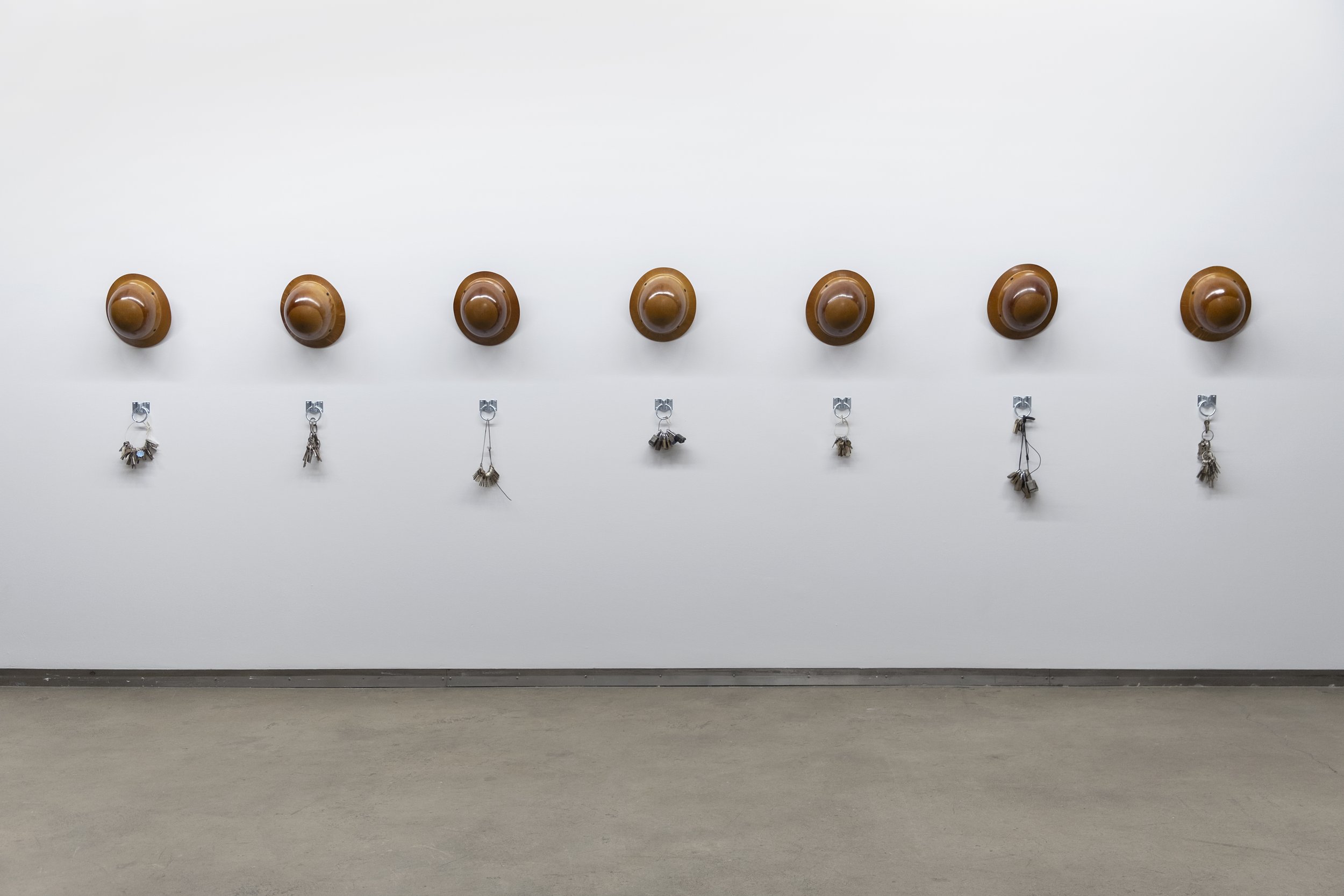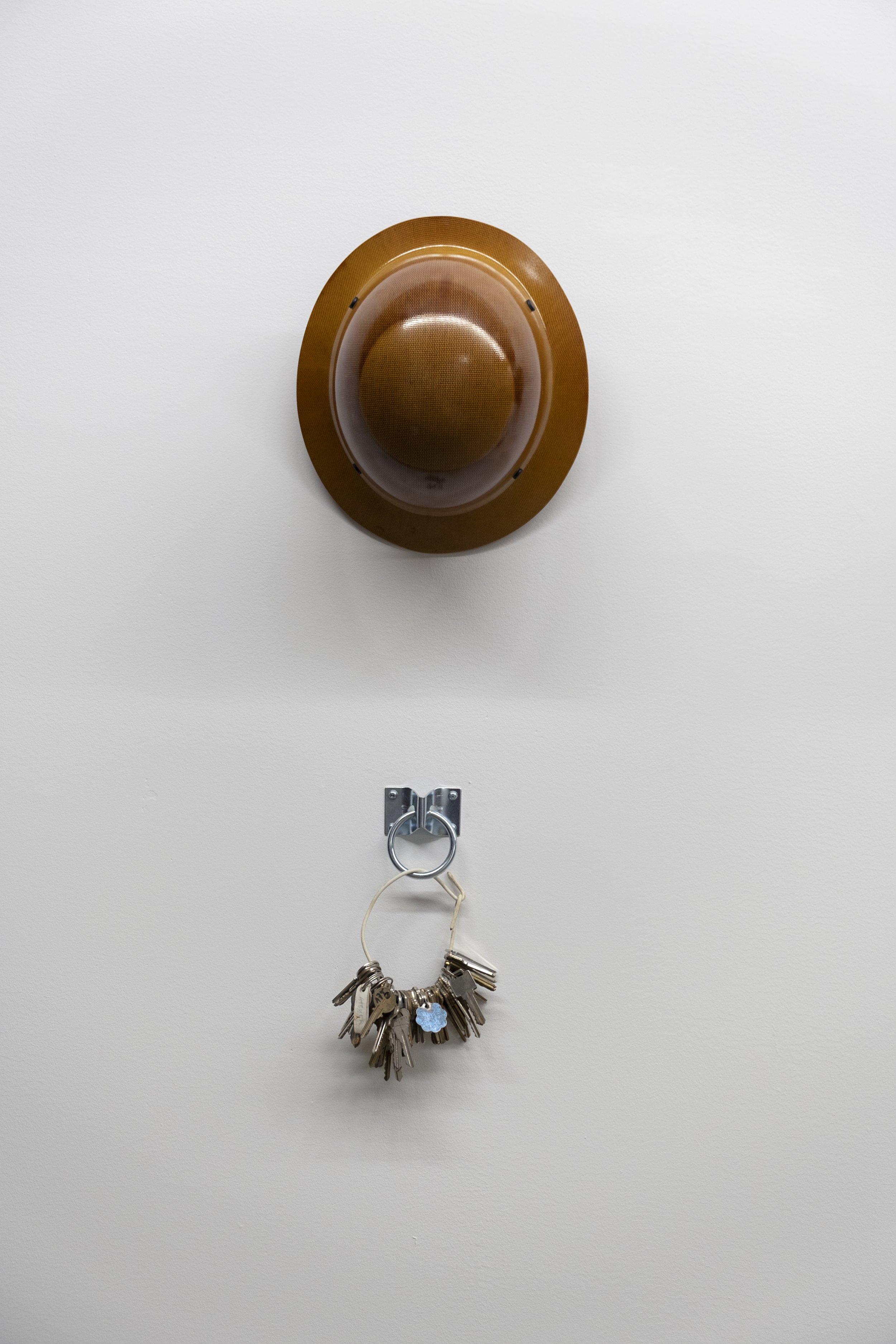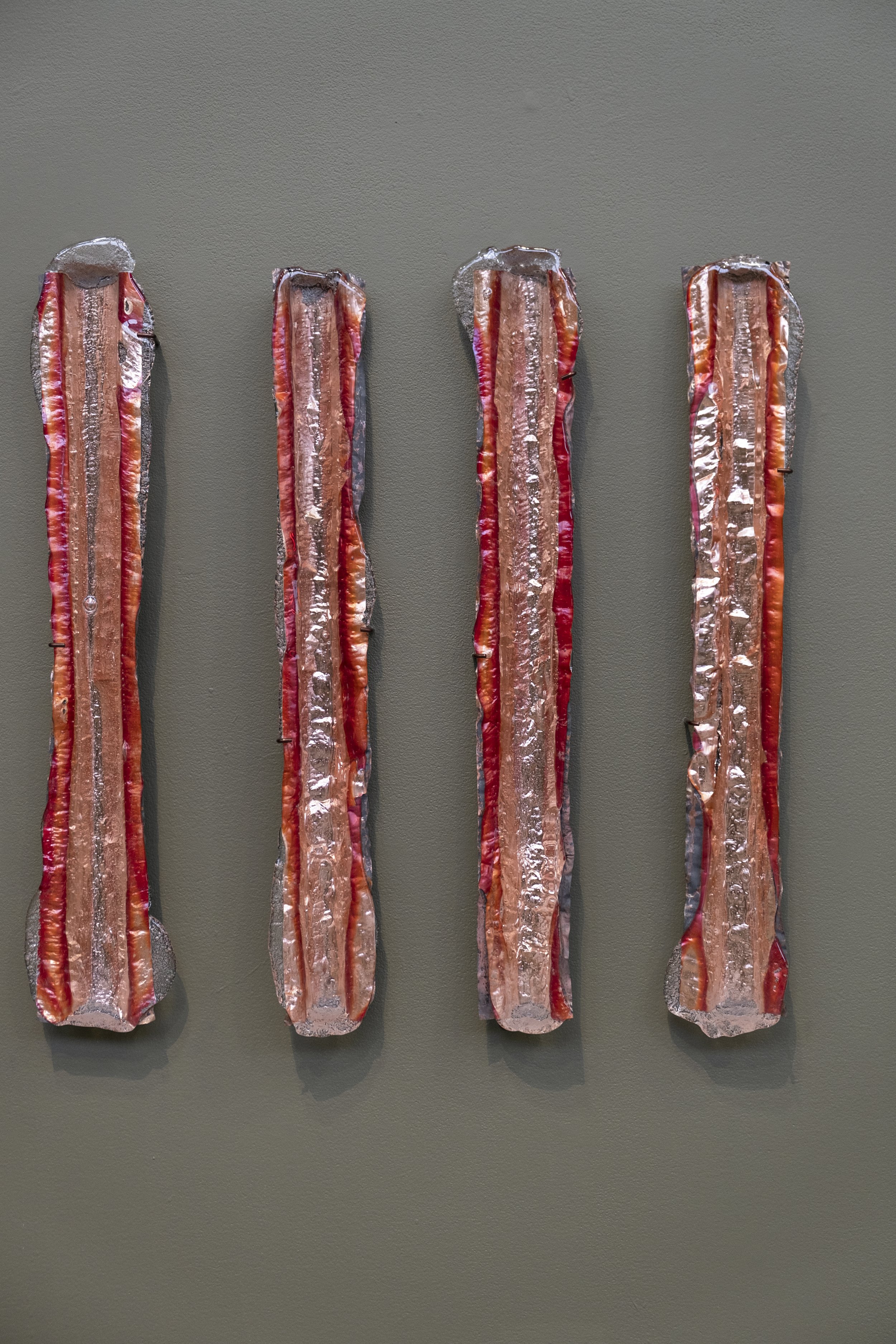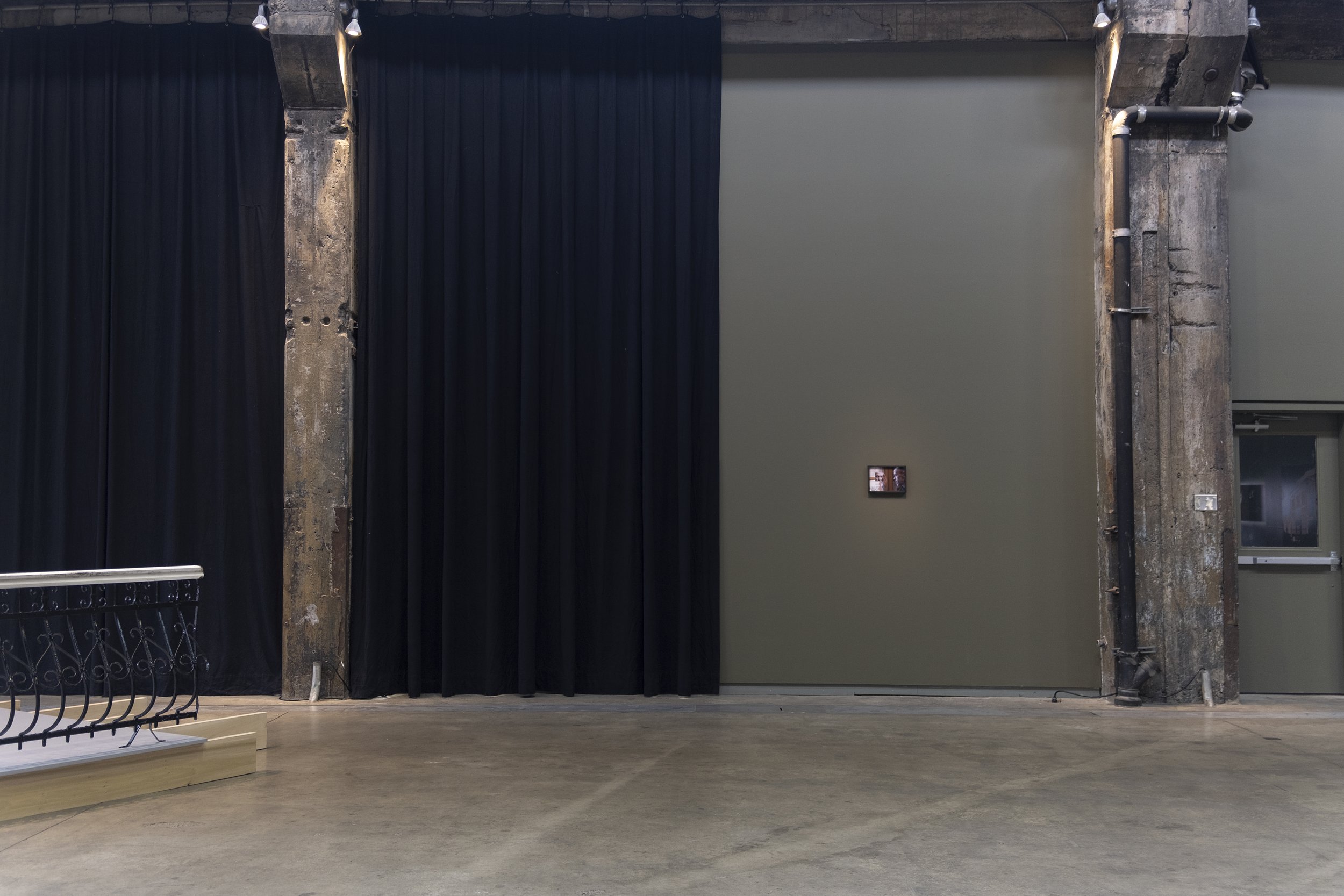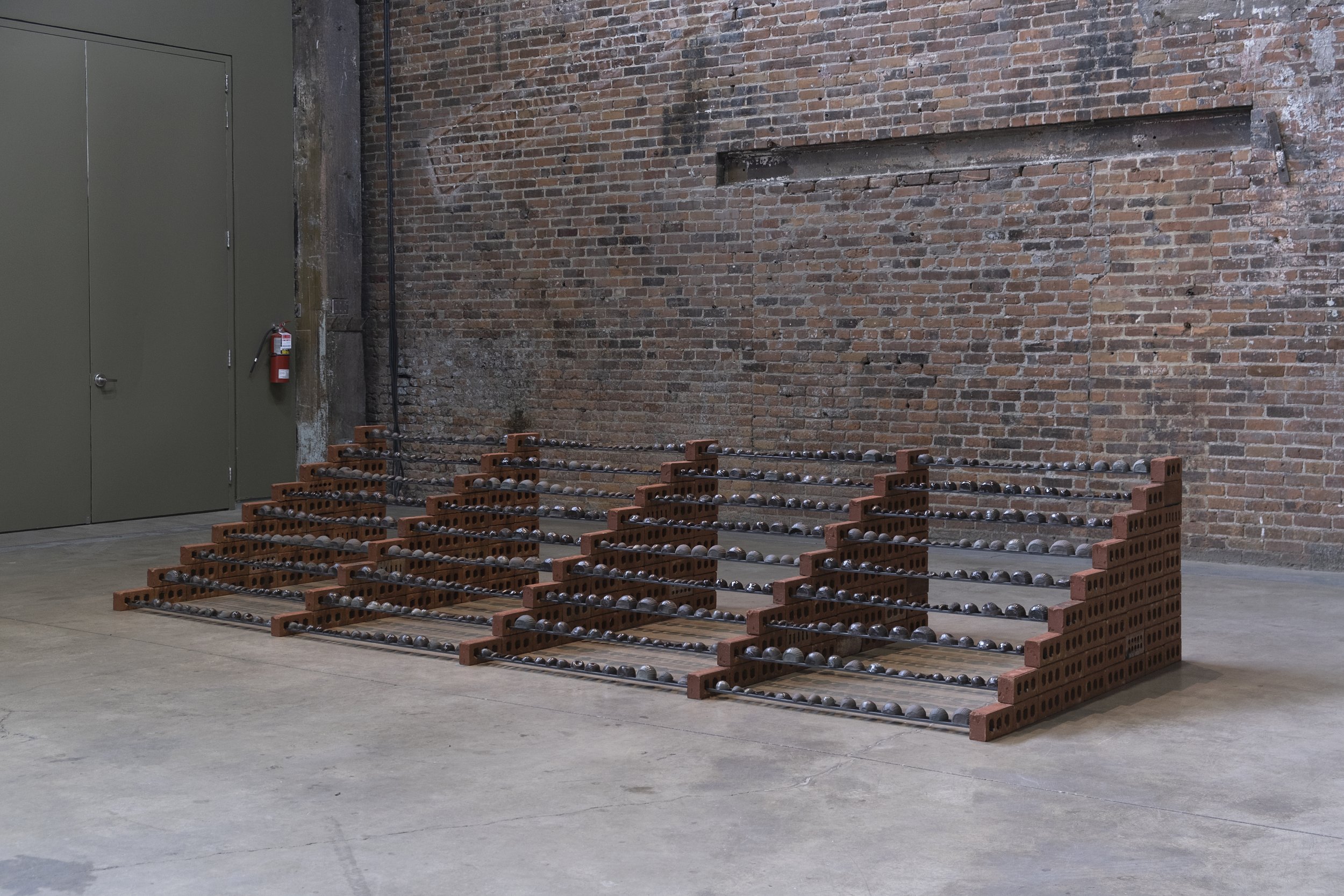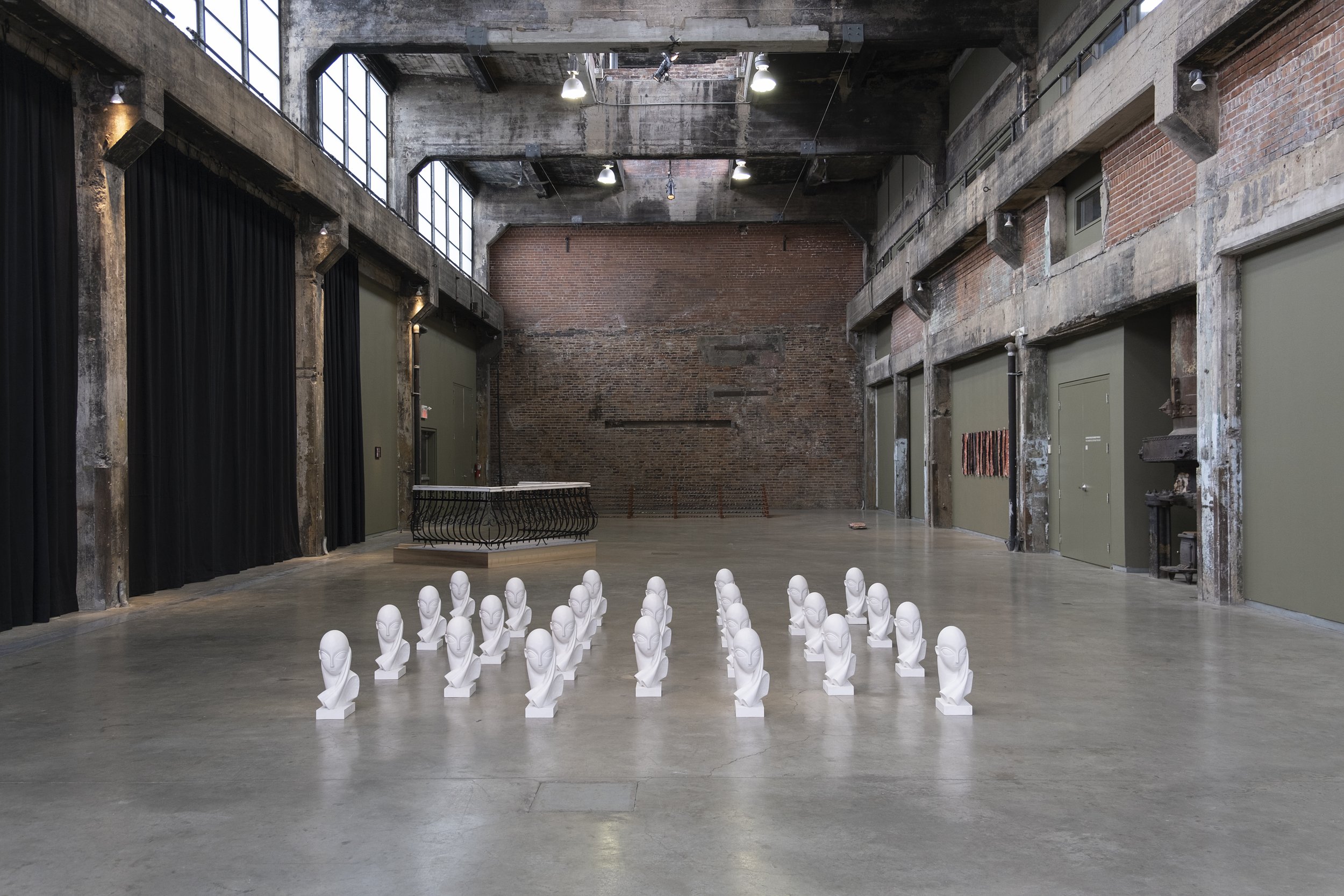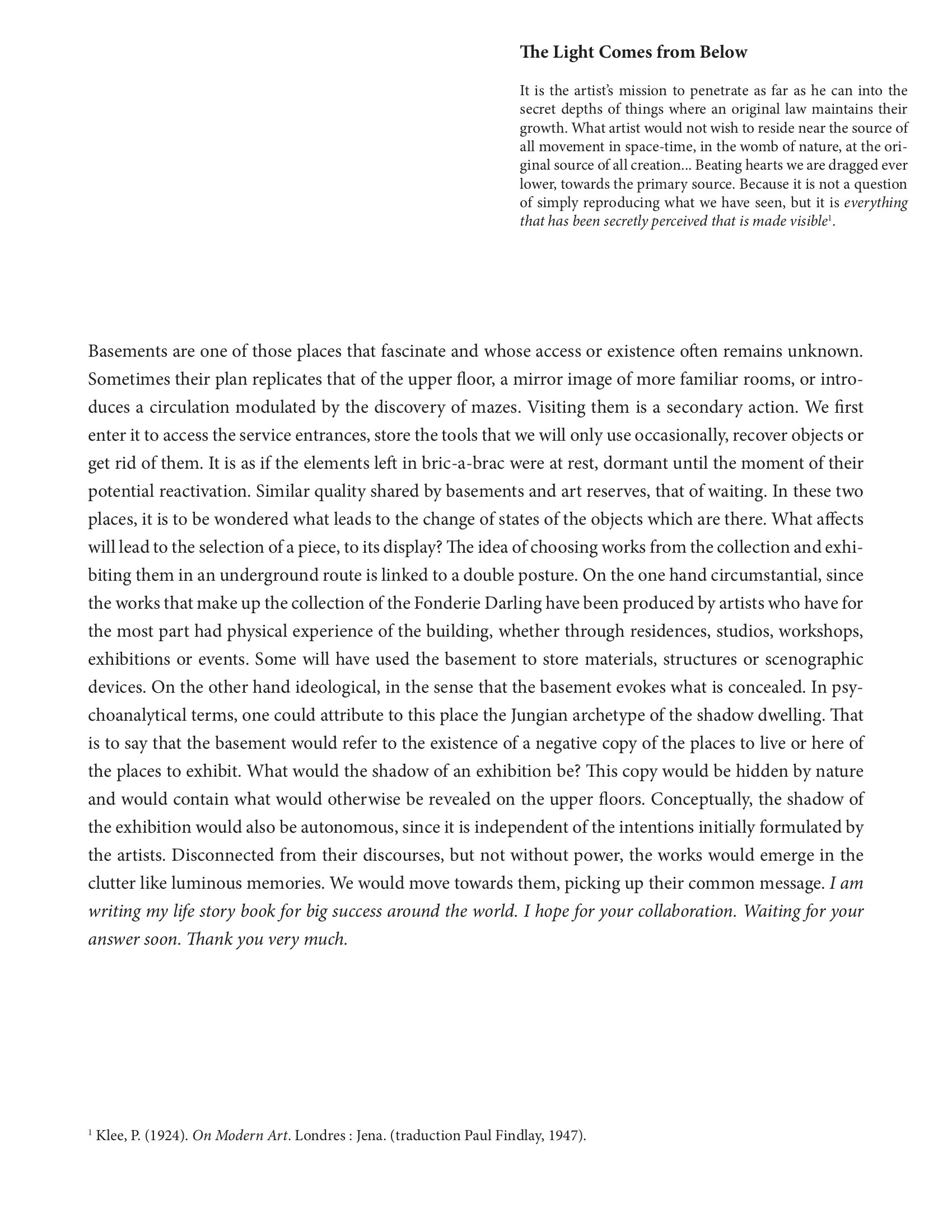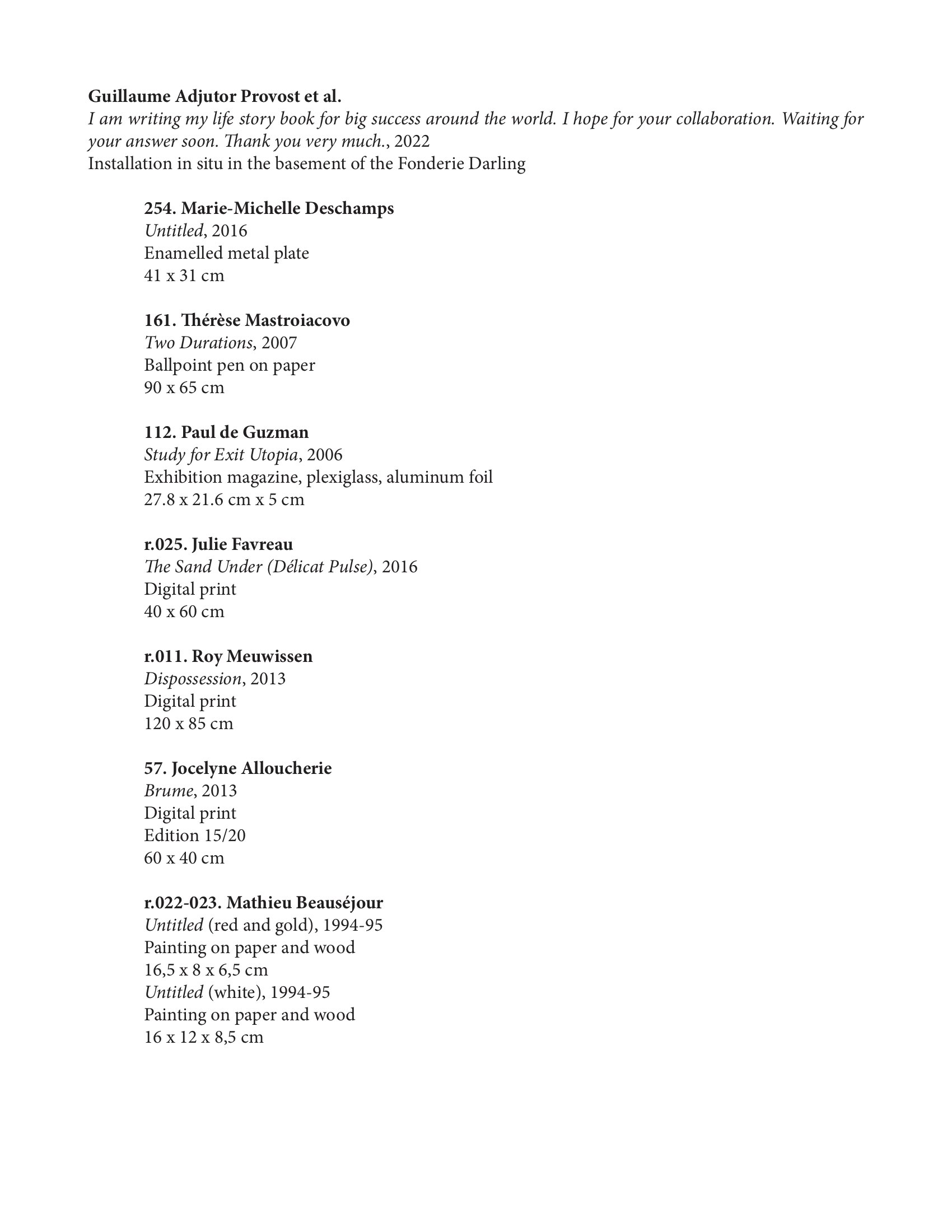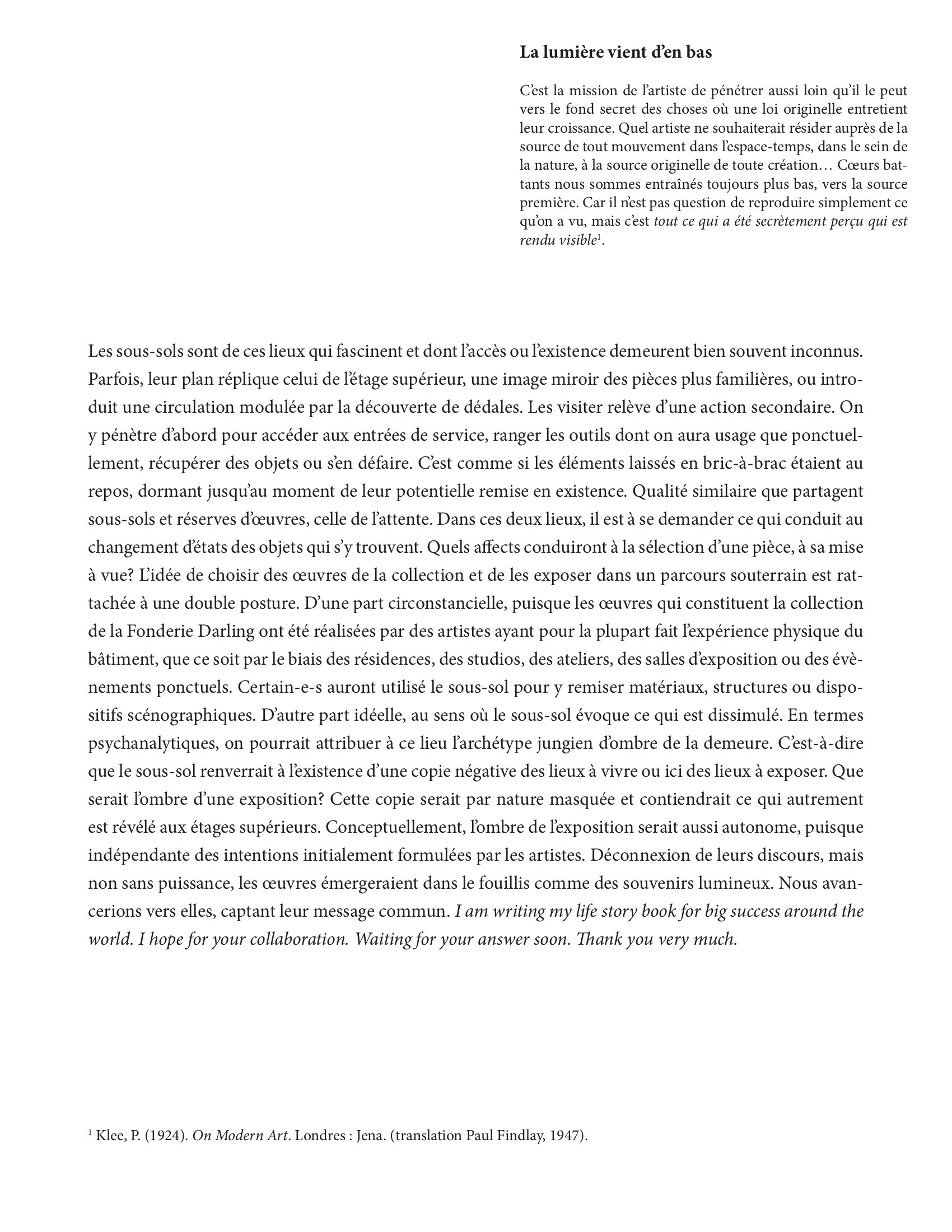Guillaume Adjutor Provost
I am writing my life story book for big success around the world. I hope for your collaboration.
Waiting for your answer soon. Thank you very much., 2022
Site-specific installation with works by Marie-Michelle Deschamps, Thérèse Mastroiacovo, Paul de Guzman, Julie Favreau,
Roy Meuwissen, Jocelyne Alloucherie, Mathieu Beauséjour.
This site-specific installation, presented mostly in Fonderie Darling’s basement, is inspired by the eclectic nature of the Fonderie Darling’s collection of artworks and artifacts, which is composed of donations of artists’ donations and historical pieces. A dozen works selected by the artist are placed in a space that is not usually accessible to visitors, and are linked by a narrative about the hopes for conservation of the works and their discourses over time. The title comes from a recurring paragraph in the correspondence of the Great Antonio, whose letters and various documents were found in Fonderie Darling’s archival holdings. To discover the installation in Fonderie Darling’s basement, the public is invited to take part in free guided tours on Thursdays at 6pm and 7pm, or at the regular price of admission tickets on Saturdays at 1pm and 2pm.
Tu m’enveloppes et je te contiens, 2022
Fonderie Darling
September 22 - December 11, 2022
Christophe Barbeau
Sameer Farooq
naakita feldman-kiss
Steve Giasson
Alexis Gros-Louis
Alexia Laferté-Coutu
Catherine Lescarbeau & Manoushka Larouche
Marion Lessard
Guillaume Adjutor Provost
Lan Florence Yee
To celebrate its 20th anniversary, Fonderie Darling launches an introspective and ambitious fall program presented in the building’s two exhibition spaces and basement. Exploring the theme of memory, ten artists turn to the annals of Fonderie Darling to create original works in response to its programing history, its collection, its architecture, or its transformation from a metal foundry to a brownfield site to a major centre of contemporary art in the Montreal cultural scene. Tu m’enveloppes et je te contiens [You Envelop Me and I Contain You] highlights artistic gestures that are rooted in practices yet can also be associated with curating practices, such as interpreting, synthesizing, framing, remembering, transforming a space, or exhibiting an object. Excerpted from a declaration of love between two characters in Jean Genet’s play The Balcony, the evocative title of this project osubtly refers to the symbiotic relationship that can exist between the labour of the artist and that of the curator, a complex dynamic that supports them in re-examining the exhibition format.
Revised or faithful reconstructions, reactivations of artworks, and appropriations constitute the interventions serving as anchor points for considering the ways in which the present gets superimposed on the past, leaving a quasi-spectral trace of what has been, of the people that have passed through, and of the events that have taken place there. Though perhaps overlooked by most, the intervention of Christophe Barbeau radically transforms the space by restoring the long black curtains and army green colour to the walls of the Main Hall. The reappearance of this enveloping green takes us back in time and makes us aware of the many layers of paint that accumulate over consecutive exhibitions, turning the space into a constantly updated palimpsest. The architectural tropes of the Main Hall and the image of successive layers of history also inspired the installation of Sameer Farooq, which is composed of approximately seven hundred ceramics in the shape of an onion, a bulb whose petals also unfold in layers like a small archive. Cast one at a time through a slow and meditative process and arranged in rows, the onions encourage a contemplative experience that is consistent with the onion’s undulating form while also recalling a creative process based on time, breath, and contact between body and material.
It is no accident that several artists used the technique of casting in their works: this gesture embodies the idea that material holds memory. It evokes the transformability of material and the metamorphoses permeating the industrial history of Fonderie Darling. Inspired by the site’s past, the sculptures of Alexia Laferté Coutu are based on the old furnace of Darling Brothers Ltd., an artifact that the artist recontextualized in an almost futuristic manner. This element, which is somewhat unusual in a gallery, is also the starting point of the video installation The Density of Dust, presented in the Small Gallery. In this work, naakita feldman-kiss investigates the material residue and lesser known history of the site and surrounding area. Listening attentively and dusting carefully like an archeologist, she examines traces of the past that are more difficult to access in the context of a stratified and saturated present. Seeking to make connections with the invisible presences that inhabit the building, restoring the original colour, putting the spotlight on the furnace, collecting the microscopic particles that permeate the site, and considering the space in relation to the bodies of the visitors and workers who have occupied it are some ways of reviving the history of Fonderie Darling and making different temporalities collide.
The continuity between past and present is explored by Marion Lessard who makes manifest the omnipresence of mediation in the experience of contemporary art and its phantasmagorical presence. Était le verbe reveals the recurrence of certain words, terms, and expressions in the institutional lexicon of Fonderie Darling, expressing them through three audio tracks transmitted in different spaces of the first floor. Adapted to the nature of each space, the different voices alter our perception of the other works and disorient us by revealing the theatrical and artificial aspect of any exhibition. Using authoritative, conversational, and intimate registers, the artist thereby questions the link that exists between architecture, language, and power. This dialectic is explored even more literally by Alexis Gros-Louis who concretizes the reference to Jean Genet’s play by placing a balcony on the Main Hall floor. Typically imagined as something elevated, this highly symbolic and performative architectural element is connected to the desire to be seen and observe others—a form of inaccessibility, power, and seduction.
Just like the reverberating words and green walls, the intervention of Steve Giasson gives a sense of déjà vu. Twenty-five reproductions of the modernist masterpiece Mademoiselle Pogany, sculpted by Constantin Brâncuși in 1913, are installed on the floor. By seizing this canonical work and the history of its appropriations, Giasson creates oneiric associations based on fragments that have left their mark on him. Multiplied, the plaster heads have a somewhat disturbing presence and remind of artworks previously exhibited at Fonderie Darling. Along with the artist, perhaps some will recall that another imitation of Brâncuși’s sculpture was presented in Guillaume Adjutor Provost’s exhibition Vapeurs. Through a series of conceptual mirror effects, Giasson pays homage to appropriation practices and a dialogic approach to art history, while making visible how the experience of a work lingers in one’s memory.
The mise en abyme effect is also present in the proposition of Guillaume Adjutor Provost who recontextualizes works created by other artists and selected from the institution’s collection. Visitors are offered guided tours of an underground circuit in the building’s basement, a secret, out-of-the-ordinary space shrouded in mystery. Excavated in the 19th century, the foundations are imagined by the artist as the physical and symbolic depths of the place. Provost makes a parallel between the contexts of collecting and showing a work and the artist’s desire to have their work be seen and conserved, questioning the unconscious motives behind this desire. Completing this tour by reflecting on the conditions of artistic production recalls a work located at the start of the exhibition, at the entrance to the Main Hall, namely the illuminated signs of Lan Florence Yee. Displayed as though on billboards, short statements about the demands of art making today, such as the obligation to fill out grant applications or to have a studio, lead to a reflection on what happens behind the scenes of creation. In the context of this exhibition, Catherine Lescarbeau and Manoushka Larouche collaborate to reconsider the exhibition label as the object that replaces the work and is presented on a series of display stands. Conceptual and self-referential, this work imagines the label as a space of negotiation between the artist’s and the institution’s voices, a site in which the metatext, the documentation and the artwork merge.
Tu m’enveloppes et je te contiens is a chance for the public to find out about the extraordinary history of Fonderie Darling through the artists’ perspectives. The programming team deliberately invited artists who know the institution well—because they’ve had an exhibition or been in a residency there or have sat on the board of directors—to be in dialogue with artists who are less familiar with it and know it more through its image or reputation. In doing so, we wanted to create an intergenerational dialogue and valorize the multiple narratives that constitute the cultural and collective consciousness of a place. In parallel with the anniversary publication Éphémère Forever, which celebrates the genesis of the organization Quartier Éphémère and its institutional appropriation of Fonderie Darling, this exhibition project is based on access to tangible and institutional documentation as well as another type of archive that is equally important: the transfer of memory. On behalf of the Fonderie Darling team and the artists, I would like to thank Caroline Andrieux, founder and Artistic Director since day one, for allowing us to delve into her precious memories.
Text by Milly-Alexandra Dery
Translated by Oana Avasilichioaei
Photo Credits : Simon Belleau / Gabriel Fournier
Artworks
Christophe Barbeau
MULTI-FUNCTIONAL ROOM (“A Post-Modern Gesture”), 2022
Architectural interventions (Benjamin Moore Army Green 2141-30, Custom black velvet curtains circa 2002).
Marion Lessard
Était le verbe, 2022
Sound installation (speakers)
Lan Florence Yee
A Room of One’s Own, to Be Shared with Others, 2022
Installation (four light panels)
Steve Giasson
Mademoiselle Pogany (1-25), 2022
after Constantin Brancusi (1913), after Austin Production Inc (1961), after Mike Bidlo (1985), after Guillaume Adjutor Provost (2019)
Sculptural installation (plaster, invitation cards, portrait of the artist in tribute to Mike Bidlo photographed by Tom Warren)
Alexis Gros-Louis
Balcony, 2022
Sculpture (iron, wood)
Sameer Farooq
Ascension (Onions), 2022
Sculptural installation (ceramics, metal rods, bricks)
Alexia Laferté Coutu
Darling Foundry, c.1918, 2022
Sculptural installation (cast glass, copper, sand)
naakita feldman-kiss
The Density of Dust, 2022
Video installation (video projection, television monitor)
Catherine Lescarbeau & Manoushka Larouche
L’invitation, 2022
Installation (display stands, labels)
Guillaume Adjutor Provost
I am writing my life story book for big success around the world. I hope for your collaboration.
Waiting for your answer soon. Thank you very much., 2022
Site-specific installation with works by Marie-Michelle Deschamps, Thérèse Mastroiacovo, Paul de Guzman, Julie Favreau,
Roy Meuwissen, Jocelyne Alloucherie, Mathieu Beauséjour.
------------------------------------------------------------------
------------------------------------------------------------------
Guillaume Adjutor Provost
I am writing my life story book for big success around the world. I hope for your collaboration.
Waiting for your answer soon. Thank you very much., 2022
Installation in situ avec les œuvres de Marie-Michelle Deschamps, Thérèse Mastroiacovo, Paul de Guzman, Julie Favreau, Roy Meuwissen, Jocelyne Alloucherie, Mathieu Beauséjour.
Cette installation in situ, présentée en majorité dans les sous-sols de la Fonderie Darling, est inspirée par le caractère éclectique de la collection d’œuvres d’art et d’artéfacts de l’institution, composée de dons d’artistes et de legs de pièces historiques. Une dizaine d’œuvres sélectionnées par l’artiste sont mises en espace dans ce lieu généralement inaccessible, et sont liées par un narratif sur les espoirs de préservation des œuvres et de leurs discours dans le temps. Le titre provient d’un paragraphe récurrent dans les correspondances du Grand Antonio, dont les lettres et divers documents se sont retrouvés dans les fonds d’archives de la Fonderie Darling. Pour découvrir l’accrochage d’œuvres proposé par l’artiste, le public est invité à prendre part aux visites guidées offertes gratuitement les jeudis à 18h et 19h, et au prix d’un billet d’entrée les samedis à 13h et 14h.
Tu m’enveloppes et je te contiens, 2022
Fonderie Darling
22 septembre - 11 décembre 2022
Christophe Barbeau
Sameer Farooq
naakita feldman-kiss
Steve Giasson
Alexis Gros-Louis
Alexia Laferté-Coutu
Catherine Lescarbeau & Manoushka Larouche
Marion Lessard
Guillaume Adjutor Provost
Lan Florence Yee
Pour célébrer ses vingt ans, la Fonderie Darling s’engage dans une programmation d’automne introspective et ambitieuse déployée dans les deux espaces d’exposition et au sous-sol des bâtiments. Sous le thème de la mémoire, dix artistes revisitent le lieu en proposant des œuvres originales, créées en réponse à l’histoire de sa programmation, sa collection, à son architecture ou à ses transformations, soit son passage d’une fonderie de métal, à une friche industrielle à un lieu d’art actuel incontournable de la scène culturelle montréalaise. Tu m’enveloppes et je te contiens met de l’avant des gestes artistiques ancrés dans une pratique pouvant parfois être associés aux pratiques du commissariat, comme l’acte d’interpréter, de synthétiser, d’encadrer, de se remémorer, de transformer un espace ou d’exposer un objet. Extrait d’une déclaration d’amour entre deux personnages de la pièce de théâtre Le Balcon de Jean Genet, le titre évocateur de ce projet réfère subtilement au rapport fusionnel qui peut exister entre le travail d’artiste et celui de commissaire, à cette dynamique complexe où l’un et l’autre se nourrissent pour repenser la forme de l’exposition.
Reconstitutions fidèles ou actualisées, réactivations d'œuvres et appropriations sont autant d’interventions qui servent de points d’ancrage pour repenser la manière dont le présent se superpose au passé, pour laisser une trace quasi spectrale de ce qui a été, des gens qui y sont passés et des événements qui y ont pris place. Tout en risquant de passer inaperçue, l’intervention de Christophe Barbeau transforme radicalement l’espace en ramenant la couleur vert armée sur les murs de la Grande salle et les grands rideaux noirs de scène. La réapparition de ce vert enveloppant opère un retour dans le temps, nous fait prendre conscience des nombreuses couches de peinture qui s’accumulent au fil des expositions qui se succèdent alors que la salle est un palimpseste constamment remis à neuf. Les tropes architecturaux de la Grande salle et l’image d’une histoire construite en strates successives inspirent également l’installation de Sameer Farooq, composée d’environ sept cents céramiques en forme d’oignons, un bulbe dont les pétales se déploient eux-mêmes en couches, comme une petite archive en soi. Moulées l’une après l’autre dans un processus lent et méditatif, les céramiques déployées en rangées invitent à une appréciation contemplative qui s’arrime à la forme ondulante de l’oignon tout en rappelant un processus de création basé sur le temps, le souffle et le contact entre le corps et la matière.
Ce n’est pas un hasard si le moulage est une technique qui revient à quelques reprises dans les propositions des artistes : ce geste incarne en lui-même l’idée d’une mémoire de la matière. Il évoque la capacité de transformation et les métamorphoses qui imprègnent l’histoire industrielle de la Fonderie Darling. S’inspirant de ce passé, les sculptures d’Alexia Laferté Coutu sont réalisées à partir de l’ancienne fournaise appartenant à la Darling Brothers Ltd., un artéfact recontextualisé de manière presque futuriste par l’artiste. Cet élément quelque peu incongru dans une salle d’exposition est aussi le point de départ de l’installation vidéo The Density of Dust présentée dans la Petite galerie, où naakita feldman-kiss enquête sur les résidus matériels et les récits qui révèlent certaines histoires moins connues du site et de ses environs. À la manière d’une archéologue, par l’écoute et un dépoussiérage méticuleux, elle s'intéresse aux traces du passé, difficile à atteindre dans le contexte d’un présent stratifié et saturé. Se connecter aux présences invisibles qui habitent le bâtiment, reconstituer la couleur d’origine, remettre en scène la fournaise, récolter les particules microscopiques qui imprègnent l’espace et penser celui-ci en lien avec le corps du public et des ouvriers qui l’ont précédemment occupé sont autant de façons de réanimer l’histoire du lieu et d’entrecroiser les temporalités.
Cette continuité entre le passé et le présent est explorée par Marion Lessard, qui rend manifeste l’omniprésence de la médiation dans l’expérience artistique contemporaine et sa présence fantomatique. Était le verbe met ainsi en évidence la récurrence de certains mots, termes et expressions dans le lexique institutionnel de la Fonderie Darling et les décline en trois bandes sonores distinctes occupant le rez-de-chaussée. Adaptées à la nature de chaque espace, les différentes voix modifient notre perception des autres œuvres et nous désorientent en révélant la nature théâtrale et artificielle de toute exposition. Utilisant des registres qui rappellent le ton autoritaire, conversationnel et intime, l’artiste questionne par le fait même le lien qui existe entre l’architecture, le langage et le pouvoir. Cette dialectique est explorée de manière encore plus littérale par Alexis Gros-Louis, qui matérialise la référence à la pièce de théâtre de Jean Genet par l’ajout d’un balcon au sol de la Grande salle. Généralement imaginé en hauteur, cet élément architectural à forte teneur symbolique et performative est à la fois lié au désir de se montrer et d’observer l’autre, à une forme d'inaccessibilité, de pouvoir et de séduction.
Tout comme les mots qui résonnent ou le vert sur les murs, l’intervention de Steve Giasson laisse l’impression d’un déjà vu. Vingt-cinq reproductions d’un chef d’œuvre de la modernité, Mademoiselle Pogany sculptée par Constantin Brâncuși en 1913, sont posées au sol. En s’emparant de cette œuvre canonique, de l’histoire de ses appropriations, Steve Giasson crée des associations oniriques à partir de fragments qui ont laissé une trace en lui. Démultipliées, ces têtes en plâtre prennent une allure quelque peu inquiétante et font émerger le souvenir d’œuvres précédemment exposées à la Fonderie Darling. Comme l’artiste, peut-être nous rappellerons-nous une autre contrefaçon de la sculpture de Brâncuși qui avait été présentée à la Fonderie Darling dans l’exposition Vapeurs, de Guillaume Adjutor Provost. Par une série d’effets de miroir conceptuels, Giasson rend hommage aux pratiques appropriationnistes et à une approche dialogique de l’histoire de l’art, tout en rendant visible la manière dont l’expérience d’une œuvre persiste dans la mémoire.
L’effet de mise en abîme se poursuit avec la proposition de Guillaume Adjutor Provost, qui recontextualise lui aussi des œuvres réalisées par d’autres artistes en les sélectionnant cette fois à partir de la collection institutionnelle. Un parcours souterrain accompagné d’une visite guidée mène ponctuellement les visiteurs dans les sous-sols du bâtiment, un espace hors norme qui revêt une part de mystère, de secret. Creusées au 19e siècle, les fondations sont ainsi imaginées par l’artiste comme les profondeurs physiques et symboliques du lieu. Provost pose les contextes de collection et de monstration d’une œuvre en parallèle avec le désir de l’artiste que son œuvre soit conservée et vue, et s’interroge sur les motivations inconscientes qui animent ce désir. Terminer ce parcours en réfléchissant sur les conditions de la production artistique rappelle une œuvre localisée au début de l’exposition à l’entrée de la Grande salle, les enseignes lumineuses de Lan Florence Yee. Comme sur un panneau publicitaire, de courtes phrases évoquent les nécessités contemporaines de la réalisation d’une œuvre, telle l’obligation de remplir des demandes de subventions ou d’occuper un espace d’atelier et amènent une réflexion sur les coulisses de la création. Dans le cadre de cette exposition, Catherine Lescarbeau et Manoushka Larouche collaborent pour repenser le cartel d’exposition comme l’objet qui prend la place de l’œuvre en s’affichant sur une série de présentoirs commerciaux. Conceptuelle et autoréférentielle, cette proposition projette le cartel comme un espace de négociation entre la voix de l’artiste et celle de l’institution, où le paratexte, la documentation et l’œuvre se confondent.
À travers le regard des artistes, Tu m’enveloppes et je te contiens est l’occasion de faire connaître au public l’histoire extraordinaire de la Fonderie Darling. Volontairement, l’équipe de programmation a invité des artistes connaissant bien l’institution - y ayant exposé, fait une résidence ou ayant siégé sur le conseil d’administration - en dialogue avec des artistes moins familiers avec l’institution, la connaissant surtout par son image ou sa réputation. Nous souhaitions ainsi mettre en place un dialogue intergénérationnel et valoriser la pluralité des récits qui constituent la conscience culturelle et collective d’un lieu. En parallèle à la production de la publication anniversaire Éphémère Forever, célébrant la genèse de l’organisme Quartier Éphémère et son appropriation institutionnelle de la Fonderie Darling, ce projet d’exposition repose sur l’accès à une documentation tangible et institutionnelle, ainsi qu’à un autre type d’archive tout aussi important : la mémoire transmise. À cet égard, au nom de l’équipe de la Fonderie Darling et des artistes, j’aimerais remercier Caroline Andrieux, fondatrice et directrice artistique depuis le premier jour, de nous avoir permis une plongée dans ses précieux souvenirs.
Texte de Milly-Alexandra Dery
Crédits photo : Simon Belleau / Gabriel Fournier
Œuvres présentées
Christophe Barbeau
SALLE MULTI-FONCTIONNELLE (“un geste post-moderne”), 2022
Interventions architecturales (Benjamin Moore Vert Armée 2141-30, Rideaux en velours noir faits sur mesure circa 2002).
Marion Lessard
Était le verbe, 2022
Installation sonore (haut parleurs)
Lan Florence Yee
A Room of One’s Own, to Be Shared with Others, 2022
Installation (quatre panneaux lumineux)
Steve Giasson
Mademoiselle Pogany (1-25), 2022
d’après Constantin Brancusi (1913), d’après Austin Production Inc. (1961), d’après Mike Bidlo (1985), d’après Guillaume Adjutor Provost (2019)
Installation sculpturale (plâtre, cartons d’invitation, portrait de l’artiste en hommage à Mike Bidlo photographié par Tom Warren)
Alexis Gros-Louis
Balcon, 2022
Sculpture (fer, bois)
Sameer Farooq
Ascension (Onions), 2022
Installation sculpturale (céramiques, tiges de métal, briques)
Alexia Laferté Coutu
Darling Foundry, c.1918, 2022
Installation sculpturale (verre coulé, cuivre, sable)
naakita feldman-kiss
The Density of Dust, 2022
Installation vidéo (projection vidéo, moniteur télévisé)
Catherine Lescarbeau & Manoushka Larouche
L’invitation, 2022
Installation (présentoirs commerciaux, cartels)
Guillaume Adjutor Provost
I am writing my life story book for big success around the world. I hope for your collaboration.
Waiting for your answer soon. Thank you very much., 2022
Installation in situ avec les œuvres de Marie-Michelle Deschamps, Thérèse Mastroiacovo, Paul de Guzman, Julie Favreau, Roy Meuwissen, Jocelyne Alloucherie, Mathieu Beauséjour.

